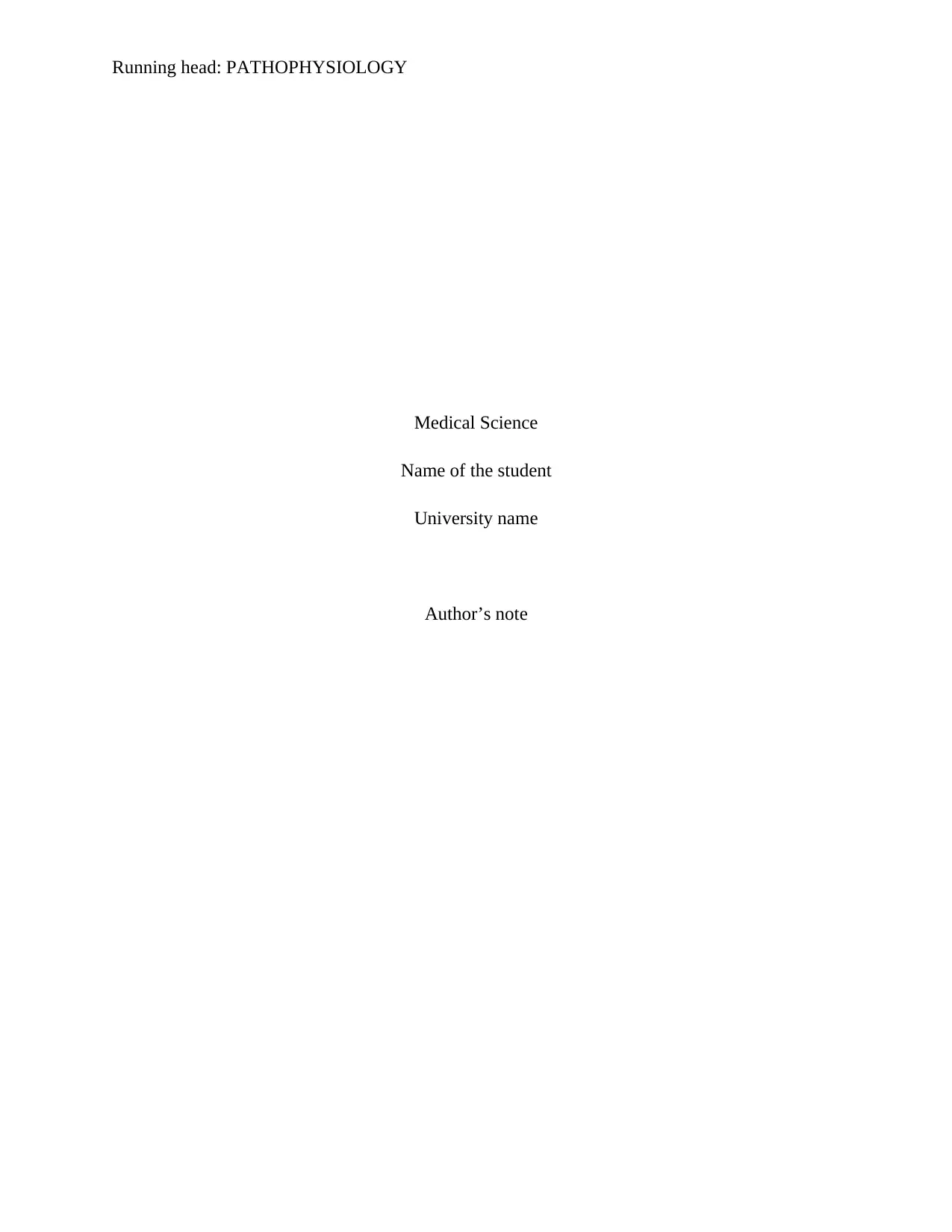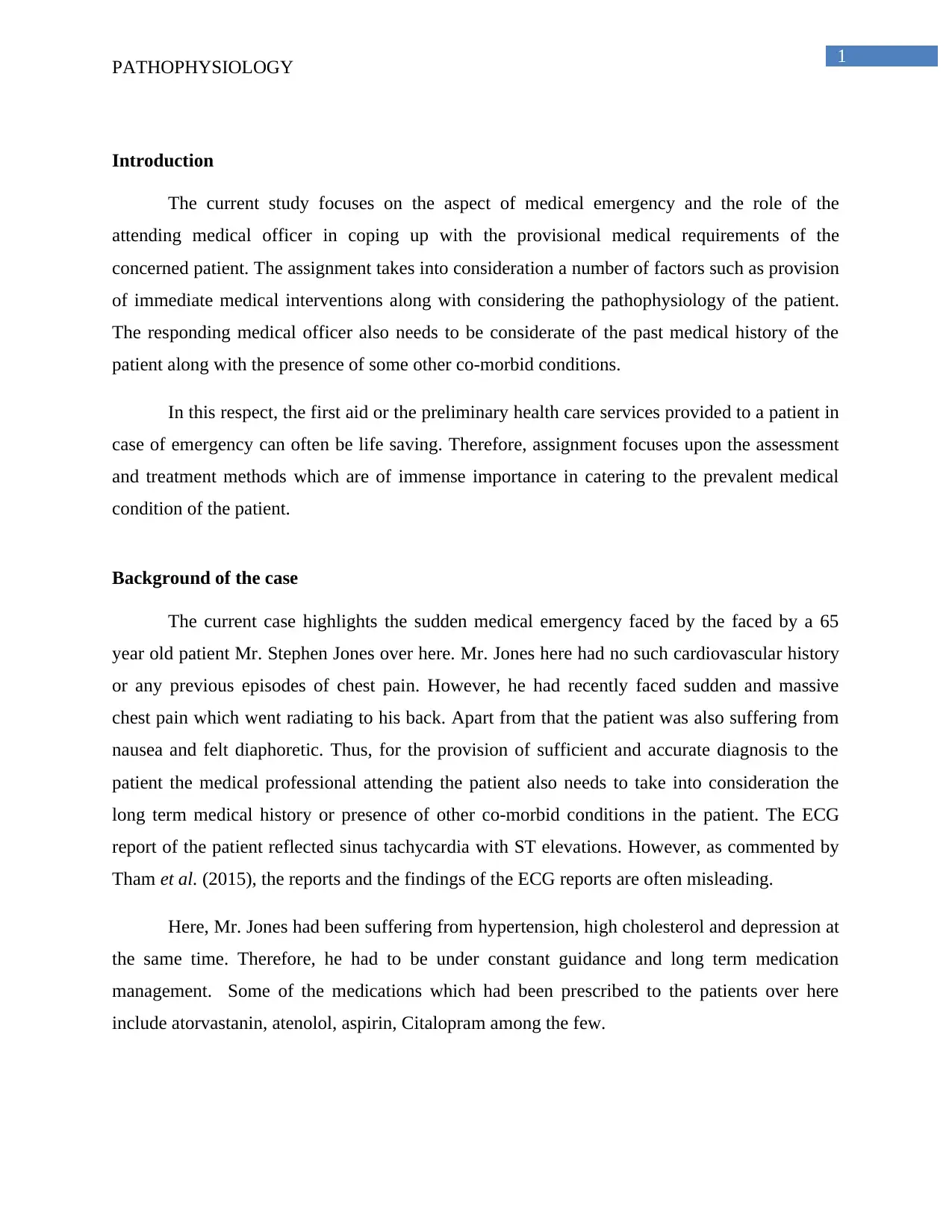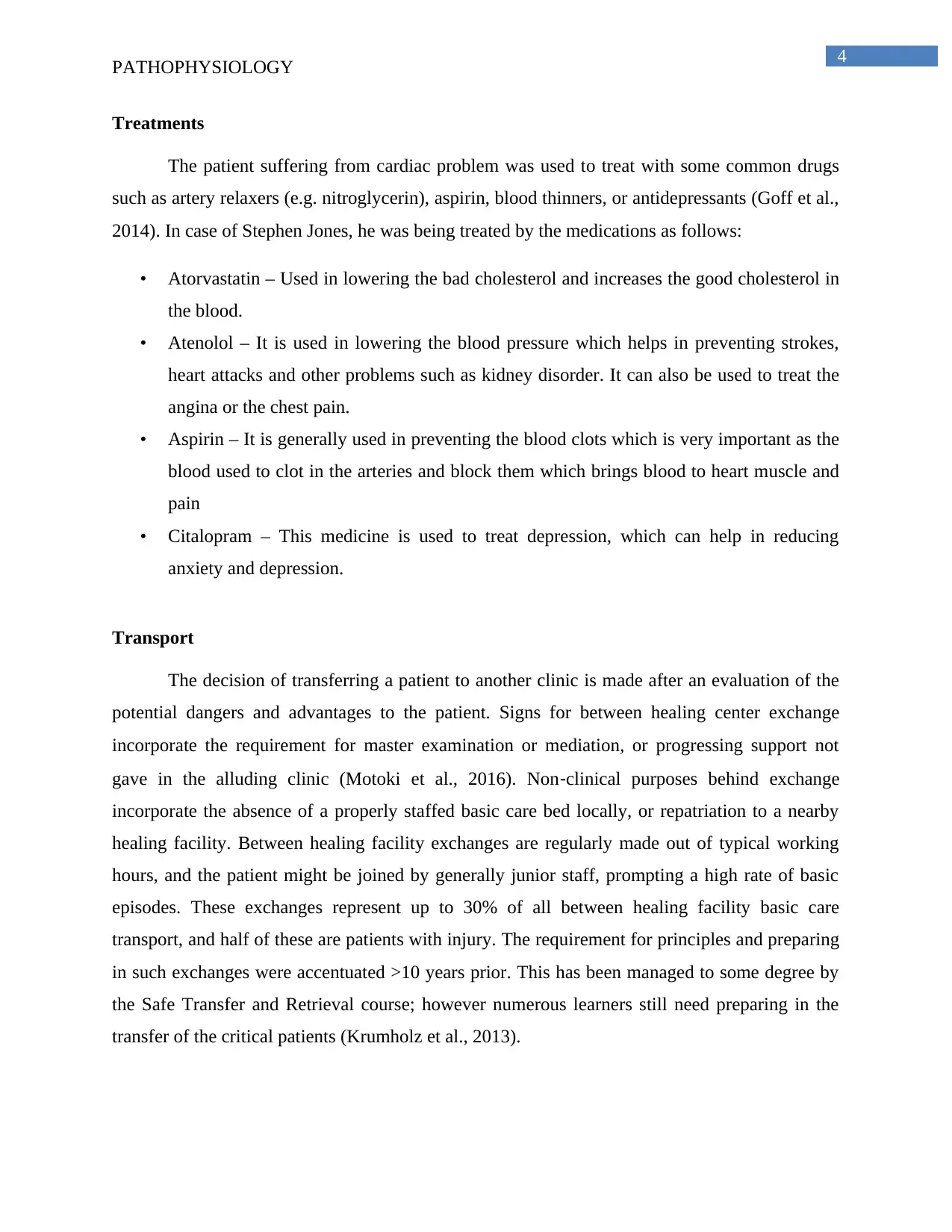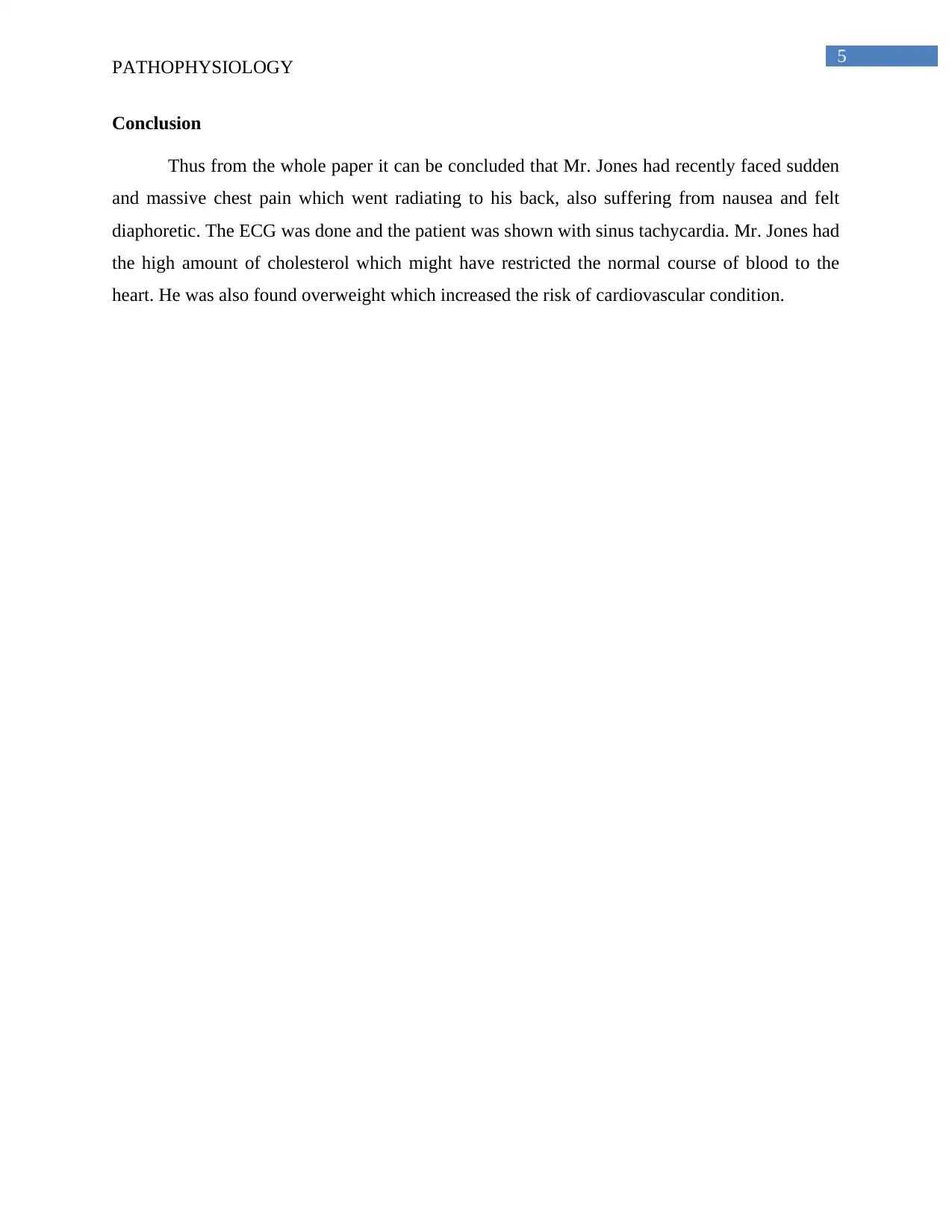Pathophysiology Report: Assessment of Cardiac Patient Case Study
VerifiedAdded on 2020/05/11
|7
|1856
|96
Report
AI Summary
This report examines the case of a 65-year-old patient, Mr. Jones, who experienced a sudden cardiac emergency. It details the patient's symptoms, medical history (including hypertension, high cholesterol, and depression), and the initial ECG findings (sinus tachycardia with ST elevations). The report delves into the provisional diagnosis, potential aetiology (including lifestyle factors and co-morbid conditions), and the epidemiology of cardiovascular diseases. It then explores the pathophysiology of cardiac arrhythmia, including the assessment methods used, such as blood pressure, pulse rate, and ECG analysis. The report also outlines the treatments administered, including medications like atorvastatin, atenolol, aspirin, and citalopram, and discusses the considerations for patient transport. The conclusion summarizes the key findings, emphasizing the importance of prompt diagnosis and management in cardiac emergencies. The report references several studies to support its findings.

Running head: PATHOPHYSIOLOGY
Medical Science
Name of the student
University name
Author’s note
Medical Science
Name of the student
University name
Author’s note
Paraphrase This Document
Need a fresh take? Get an instant paraphrase of this document with our AI Paraphraser

1
PATHOPHYSIOLOGY
Introduction
The current study focuses on the aspect of medical emergency and the role of the
attending medical officer in coping up with the provisional medical requirements of the
concerned patient. The assignment takes into consideration a number of factors such as provision
of immediate medical interventions along with considering the pathophysiology of the patient.
The responding medical officer also needs to be considerate of the past medical history of the
patient along with the presence of some other co-morbid conditions.
In this respect, the first aid or the preliminary health care services provided to a patient in
case of emergency can often be life saving. Therefore, assignment focuses upon the assessment
and treatment methods which are of immense importance in catering to the prevalent medical
condition of the patient.
Background of the case
The current case highlights the sudden medical emergency faced by the faced by a 65
year old patient Mr. Stephen Jones over here. Mr. Jones here had no such cardiovascular history
or any previous episodes of chest pain. However, he had recently faced sudden and massive
chest pain which went radiating to his back. Apart from that the patient was also suffering from
nausea and felt diaphoretic. Thus, for the provision of sufficient and accurate diagnosis to the
patient the medical professional attending the patient also needs to take into consideration the
long term medical history or presence of other co-morbid conditions in the patient. The ECG
report of the patient reflected sinus tachycardia with ST elevations. However, as commented by
Tham et al. (2015), the reports and the findings of the ECG reports are often misleading.
Here, Mr. Jones had been suffering from hypertension, high cholesterol and depression at
the same time. Therefore, he had to be under constant guidance and long term medication
management. Some of the medications which had been prescribed to the patients over here
include atorvastanin, atenolol, aspirin, Citalopram among the few.
PATHOPHYSIOLOGY
Introduction
The current study focuses on the aspect of medical emergency and the role of the
attending medical officer in coping up with the provisional medical requirements of the
concerned patient. The assignment takes into consideration a number of factors such as provision
of immediate medical interventions along with considering the pathophysiology of the patient.
The responding medical officer also needs to be considerate of the past medical history of the
patient along with the presence of some other co-morbid conditions.
In this respect, the first aid or the preliminary health care services provided to a patient in
case of emergency can often be life saving. Therefore, assignment focuses upon the assessment
and treatment methods which are of immense importance in catering to the prevalent medical
condition of the patient.
Background of the case
The current case highlights the sudden medical emergency faced by the faced by a 65
year old patient Mr. Stephen Jones over here. Mr. Jones here had no such cardiovascular history
or any previous episodes of chest pain. However, he had recently faced sudden and massive
chest pain which went radiating to his back. Apart from that the patient was also suffering from
nausea and felt diaphoretic. Thus, for the provision of sufficient and accurate diagnosis to the
patient the medical professional attending the patient also needs to take into consideration the
long term medical history or presence of other co-morbid conditions in the patient. The ECG
report of the patient reflected sinus tachycardia with ST elevations. However, as commented by
Tham et al. (2015), the reports and the findings of the ECG reports are often misleading.
Here, Mr. Jones had been suffering from hypertension, high cholesterol and depression at
the same time. Therefore, he had to be under constant guidance and long term medication
management. Some of the medications which had been prescribed to the patients over here
include atorvastanin, atenolol, aspirin, Citalopram among the few.

2
PATHOPHYSIOLOGY
Provisional diagnosis
The patient had been suffering from sudden and massive chest pain and no attributable
past cardiac conditions. Therefore, the immediate prognosis which could be provided to the
patient includes conducting ECG tests. In this context, the ECG reports revealed sinus
tachycardia with ST elevations. This could lead to misleading results as such symptoms are also
expressed in cases such as cardiac ischemia. However, they could be warning signs of
myocardial infarction which could be followed up with the help of further scanning and analysis
(Andrade et al. 2014). Therefore as immediate intervention and control the patient needs to be
put under emergency treatment process where the immediate oxygen supply could be provided to
the patient.
Aetiology
The development of a cardiac condition could be attributed to a number of factors such as
the presence of cardiovascular conditions within the family. Apart from that the presence of co-
morbid conditions such as diabetes, hypertension and high cholesterol can also add up to the
health grievances. In this context, Mr. Jones had high amount of cholesterol which might have
restricted the normal course of blood to the heart. He was also found to overweight increased the
risk of cardiovascular condition in the patients manifold times. The patient here also had been
affected with hypertension and was taking medications for depression. Along with that intake of
medicines such as aspirin in higher doses could also interfere with the rhythmic beating of the
heart (Alpert et al. 2014). Additionally, blockage of the coronary arteries could trigger
ventricular fibrillation leading to cardiac arrest.
Epidemiology
The epidemiology of cardiovascular disease varies according to age, gender and lifestyle
approaches followed by a specific individual or within a community. In this respect, the cultural
values or paradoxes possessed by individual group of people further govern their daily life
habits. As per reports and evidences at least 1 out of 5 people with history of obesity,
hypertension and other co-morbid conditions experience major cardiac symptoms in their life.
The statistics point at greater amount of cases being reported from the western countries and is
PATHOPHYSIOLOGY
Provisional diagnosis
The patient had been suffering from sudden and massive chest pain and no attributable
past cardiac conditions. Therefore, the immediate prognosis which could be provided to the
patient includes conducting ECG tests. In this context, the ECG reports revealed sinus
tachycardia with ST elevations. This could lead to misleading results as such symptoms are also
expressed in cases such as cardiac ischemia. However, they could be warning signs of
myocardial infarction which could be followed up with the help of further scanning and analysis
(Andrade et al. 2014). Therefore as immediate intervention and control the patient needs to be
put under emergency treatment process where the immediate oxygen supply could be provided to
the patient.
Aetiology
The development of a cardiac condition could be attributed to a number of factors such as
the presence of cardiovascular conditions within the family. Apart from that the presence of co-
morbid conditions such as diabetes, hypertension and high cholesterol can also add up to the
health grievances. In this context, Mr. Jones had high amount of cholesterol which might have
restricted the normal course of blood to the heart. He was also found to overweight increased the
risk of cardiovascular condition in the patients manifold times. The patient here also had been
affected with hypertension and was taking medications for depression. Along with that intake of
medicines such as aspirin in higher doses could also interfere with the rhythmic beating of the
heart (Alpert et al. 2014). Additionally, blockage of the coronary arteries could trigger
ventricular fibrillation leading to cardiac arrest.
Epidemiology
The epidemiology of cardiovascular disease varies according to age, gender and lifestyle
approaches followed by a specific individual or within a community. In this respect, the cultural
values or paradoxes possessed by individual group of people further govern their daily life
habits. As per reports and evidences at least 1 out of 5 people with history of obesity,
hypertension and other co-morbid conditions experience major cardiac symptoms in their life.
The statistics point at greater amount of cases being reported from the western countries and is
⊘ This is a preview!⊘
Do you want full access?
Subscribe today to unlock all pages.

Trusted by 1+ million students worldwide

3
PATHOPHYSIOLOGY
directly proportional to the ageing population or the middle aged population of 53-65
(Karpawich, 2015).
Pathophysiology
Cardiac arrhythmia is a type of condition in which the heart beats in an irregular manner.
The cardiovascular arrhythmia is the variation from the norm of the working of the myocardium.
Side effects, for example, unsteadiness, palpitations, and syncope are visit griped issues of the
patients.
Despite the particular type of chest pain, the pathogenesis of the arrhythmias can be
categorized as one of three essential instruments: upgraded automaticity, activated action, or re-
entry. Ischemia, disturbances of electrolyte, scarring, medications and different factors may
upgrade or degrade automaticity in different regions (Borlaug, 2014). Control of automaticity of
the sinoatrial (SA) node can bring dysfunction in the sinus node and “sick sinus syndrome”
(SSS), which is as yet the most well-known sign for perpetual pacemaker implantation. As
opposed to smothered automaticity, improved automaticity can bring about numerous cardiac
problems, both atrial and ventricular.
Assessment
During the cardiac arrhythmia the following points are to be assessed for the
determination of arrhythmia:
• Assessment of the normal blood pressure
• Assessment of the normal pulse rate
• Assessment of normal heart rate
• Assessing the respiration
The patient was then assessed for the following:
• Dizziness
• Then after the patient is being hospitalized the ECG is being done.
• EKG rhythm strips are continually analysed to track the cardiac problem.
PATHOPHYSIOLOGY
directly proportional to the ageing population or the middle aged population of 53-65
(Karpawich, 2015).
Pathophysiology
Cardiac arrhythmia is a type of condition in which the heart beats in an irregular manner.
The cardiovascular arrhythmia is the variation from the norm of the working of the myocardium.
Side effects, for example, unsteadiness, palpitations, and syncope are visit griped issues of the
patients.
Despite the particular type of chest pain, the pathogenesis of the arrhythmias can be
categorized as one of three essential instruments: upgraded automaticity, activated action, or re-
entry. Ischemia, disturbances of electrolyte, scarring, medications and different factors may
upgrade or degrade automaticity in different regions (Borlaug, 2014). Control of automaticity of
the sinoatrial (SA) node can bring dysfunction in the sinus node and “sick sinus syndrome”
(SSS), which is as yet the most well-known sign for perpetual pacemaker implantation. As
opposed to smothered automaticity, improved automaticity can bring about numerous cardiac
problems, both atrial and ventricular.
Assessment
During the cardiac arrhythmia the following points are to be assessed for the
determination of arrhythmia:
• Assessment of the normal blood pressure
• Assessment of the normal pulse rate
• Assessment of normal heart rate
• Assessing the respiration
The patient was then assessed for the following:
• Dizziness
• Then after the patient is being hospitalized the ECG is being done.
• EKG rhythm strips are continually analysed to track the cardiac problem.
Paraphrase This Document
Need a fresh take? Get an instant paraphrase of this document with our AI Paraphraser

4
PATHOPHYSIOLOGY
Treatments
The patient suffering from cardiac problem was used to treat with some common drugs
such as artery relaxers (e.g. nitroglycerin), aspirin, blood thinners, or antidepressants (Goff et al.,
2014). In case of Stephen Jones, he was being treated by the medications as follows:
• Atorvastatin – Used in lowering the bad cholesterol and increases the good cholesterol in
the blood.
• Atenolol – It is used in lowering the blood pressure which helps in preventing strokes,
heart attacks and other problems such as kidney disorder. It can also be used to treat the
angina or the chest pain.
• Aspirin – It is generally used in preventing the blood clots which is very important as the
blood used to clot in the arteries and block them which brings blood to heart muscle and
pain
• Citalopram – This medicine is used to treat depression, which can help in reducing
anxiety and depression.
Transport
The decision of transferring a patient to another clinic is made after an evaluation of the
potential dangers and advantages to the patient. Signs for between healing center exchange
incorporate the requirement for master examination or mediation, or progressing support not
gave in the alluding clinic (Motoki et al., 2016). Non‐clinical purposes behind exchange
incorporate the absence of a properly staffed basic care bed locally, or repatriation to a nearby
healing facility. Between healing facility exchanges are regularly made out of typical working
hours, and the patient might be joined by generally junior staff, prompting a high rate of basic
episodes. These exchanges represent up to 30% of all between healing facility basic care
transport, and half of these are patients with injury. The requirement for principles and preparing
in such exchanges were accentuated >10 years prior. This has been managed to some degree by
the Safe Transfer and Retrieval course; however numerous learners still need preparing in the
transfer of the critical patients (Krumholz et al., 2013).
PATHOPHYSIOLOGY
Treatments
The patient suffering from cardiac problem was used to treat with some common drugs
such as artery relaxers (e.g. nitroglycerin), aspirin, blood thinners, or antidepressants (Goff et al.,
2014). In case of Stephen Jones, he was being treated by the medications as follows:
• Atorvastatin – Used in lowering the bad cholesterol and increases the good cholesterol in
the blood.
• Atenolol – It is used in lowering the blood pressure which helps in preventing strokes,
heart attacks and other problems such as kidney disorder. It can also be used to treat the
angina or the chest pain.
• Aspirin – It is generally used in preventing the blood clots which is very important as the
blood used to clot in the arteries and block them which brings blood to heart muscle and
pain
• Citalopram – This medicine is used to treat depression, which can help in reducing
anxiety and depression.
Transport
The decision of transferring a patient to another clinic is made after an evaluation of the
potential dangers and advantages to the patient. Signs for between healing center exchange
incorporate the requirement for master examination or mediation, or progressing support not
gave in the alluding clinic (Motoki et al., 2016). Non‐clinical purposes behind exchange
incorporate the absence of a properly staffed basic care bed locally, or repatriation to a nearby
healing facility. Between healing facility exchanges are regularly made out of typical working
hours, and the patient might be joined by generally junior staff, prompting a high rate of basic
episodes. These exchanges represent up to 30% of all between healing facility basic care
transport, and half of these are patients with injury. The requirement for principles and preparing
in such exchanges were accentuated >10 years prior. This has been managed to some degree by
the Safe Transfer and Retrieval course; however numerous learners still need preparing in the
transfer of the critical patients (Krumholz et al., 2013).

5
PATHOPHYSIOLOGY
Conclusion
Thus from the whole paper it can be concluded that Mr. Jones had recently faced sudden
and massive chest pain which went radiating to his back, also suffering from nausea and felt
diaphoretic. The ECG was done and the patient was shown with sinus tachycardia. Mr. Jones had
the high amount of cholesterol which might have restricted the normal course of blood to the
heart. He was also found overweight which increased the risk of cardiovascular condition.
PATHOPHYSIOLOGY
Conclusion
Thus from the whole paper it can be concluded that Mr. Jones had recently faced sudden
and massive chest pain which went radiating to his back, also suffering from nausea and felt
diaphoretic. The ECG was done and the patient was shown with sinus tachycardia. Mr. Jones had
the high amount of cholesterol which might have restricted the normal course of blood to the
heart. He was also found overweight which increased the risk of cardiovascular condition.
⊘ This is a preview!⊘
Do you want full access?
Subscribe today to unlock all pages.

Trusted by 1+ million students worldwide

6
PATHOPHYSIOLOGY
References
Alpert, M. A., Lavie, C. J., Agrawal, H., Aggarwal, K. B., & Kumar, S. A. (2014). Obesity and
heart failure: epidemiology, pathophysiology, clinical manifestations, and
management. Translational Research, 164(4), 345-356.
Andrade, J., Khairy, P., Dobrev, D., & Nattel, S. (2014). The clinical profile and
pathophysiology of atrial fibrillation. Circulation research, 114(9), 1453-1468.
Borlaug, B. A. (2014). The pathophysiology of heart failure with preserved ejection
fraction. Nature Reviews Cardiology, 11(9), 507-515.
Goff, D. C., Lloyd-Jones, D. M., Bennett, G., Coady, S., D’Agostino, R. B., Gibbons, R., ... &
Robinson, J. G. (2014). 2013 ACC/AHA guideline on the assessment of cardiovascular
risk. Journal of the American College of Cardiology, 63(25 Part B), 2935-2959.
Karpawich, P. P. (2015). Pathophysiology of Cardiac Arrhythmias: Arrhythmogenesis and Types
of Arrhythmias. In Pathophysiology and Pharmacotherapy of Cardiovascular
Disease (pp. 1003-1014). Springer International Publishing.
Krumholz, H. M., Lin, Z., Keenan, P. S., Chen, J., Ross, J. S., Drye, E. E., ... & Normand, S. L.
T. (2013). Relationship between hospital readmission and mortality rates for patients
hospitalized with acute myocardial infarction, heart failure, or pneumonia. Jama, 309(6),
587-593.
Motoki, N., Inaba, Y., Matsuzaki, S., Akazawa, Y., Nishimura, T., Fukuyama, T., & Koike, K.
(2016). Successful treatment of arrhythmia-induced cardiomyopathy in an infant with
tuberous sclerosis complex. BMC pediatrics, 16(1), 16.
Tham, Y. K., Bernardo, B. C., Ooi, J. Y., Weeks, K. L., & McMullen, J. R. (2015).
Pathophysiology of cardiac hypertrophy and heart failure: signaling pathways and novel
therapeutic targets. Archives of toxicology, 89(9), 1401-1438.
PATHOPHYSIOLOGY
References
Alpert, M. A., Lavie, C. J., Agrawal, H., Aggarwal, K. B., & Kumar, S. A. (2014). Obesity and
heart failure: epidemiology, pathophysiology, clinical manifestations, and
management. Translational Research, 164(4), 345-356.
Andrade, J., Khairy, P., Dobrev, D., & Nattel, S. (2014). The clinical profile and
pathophysiology of atrial fibrillation. Circulation research, 114(9), 1453-1468.
Borlaug, B. A. (2014). The pathophysiology of heart failure with preserved ejection
fraction. Nature Reviews Cardiology, 11(9), 507-515.
Goff, D. C., Lloyd-Jones, D. M., Bennett, G., Coady, S., D’Agostino, R. B., Gibbons, R., ... &
Robinson, J. G. (2014). 2013 ACC/AHA guideline on the assessment of cardiovascular
risk. Journal of the American College of Cardiology, 63(25 Part B), 2935-2959.
Karpawich, P. P. (2015). Pathophysiology of Cardiac Arrhythmias: Arrhythmogenesis and Types
of Arrhythmias. In Pathophysiology and Pharmacotherapy of Cardiovascular
Disease (pp. 1003-1014). Springer International Publishing.
Krumholz, H. M., Lin, Z., Keenan, P. S., Chen, J., Ross, J. S., Drye, E. E., ... & Normand, S. L.
T. (2013). Relationship between hospital readmission and mortality rates for patients
hospitalized with acute myocardial infarction, heart failure, or pneumonia. Jama, 309(6),
587-593.
Motoki, N., Inaba, Y., Matsuzaki, S., Akazawa, Y., Nishimura, T., Fukuyama, T., & Koike, K.
(2016). Successful treatment of arrhythmia-induced cardiomyopathy in an infant with
tuberous sclerosis complex. BMC pediatrics, 16(1), 16.
Tham, Y. K., Bernardo, B. C., Ooi, J. Y., Weeks, K. L., & McMullen, J. R. (2015).
Pathophysiology of cardiac hypertrophy and heart failure: signaling pathways and novel
therapeutic targets. Archives of toxicology, 89(9), 1401-1438.
1 out of 7
Related Documents
Your All-in-One AI-Powered Toolkit for Academic Success.
+13062052269
info@desklib.com
Available 24*7 on WhatsApp / Email
![[object Object]](/_next/static/media/star-bottom.7253800d.svg)
Unlock your academic potential
Copyright © 2020–2025 A2Z Services. All Rights Reserved. Developed and managed by ZUCOL.




